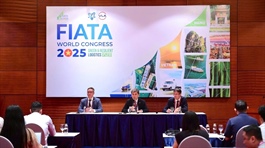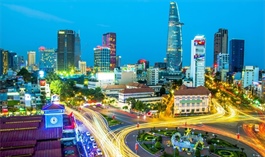Vietnam rides out the storm to hold firm on its 8 per cent growth goal
Vietnam rides out the storm to hold firm on its 8 per cent growth goal
Nguyen Thi Mai Hanh, head of the National Accounts System Department at the General Statistics Office under the Ministry of Finance, shares insights on how Vietnam aims to stay on track for its ambitious 8 per cent growth target in 2025 despite rising external and environmental pressures.
Vietnam’s economy grew 7.85 per cent in the first three quarters of the year, just below the 8 per cent target. How do you assess this performance in terms of economic resilience?

Nguyen Thi Mai Hanh, head of the National Accounts System Department at the General Statistics Office under the Ministry of Finance |
A growth rate of 7.85 per cent over nine months is acceptable, especially considering the country has been struck by numerous storms since the start of the year. Typhoon Bualoi and subsequent flooding alone caused damages estimated at $800 million.
In this context, the 7.85 per cent growth can be considered quite impressive, as it marks the highest rate since 2011. More importantly, growth has followed a positive trajectory, accelerating each quarter: from a slightly more than 7 per cent increase in the first quarter, rising to almost 8.2 per cent in the second, and reaching 8.23 per cent in the third.
Manufacturing and processing industries were the main growth drivers, expanding by over 9.9 per cent. Domestic consumption in goods, services, and tourism also surged, especially during national holidays and celebration events, which gave a strong boost to the trade and services sector.
Following Typhoon Bualoi, Vietnam was hit again by Typhoon Matmo, compounding the damage. Have these successive natural disasters significantly affected investment, production, and daily life?
2025 has been a year of continual natural disasters. Typhoons Ragasa, Bualoi, and Matmo struck in quick succession, hitting before recovery efforts from previous storms and floods had been completed.
These calamities have had a widespread negative impact on all aspects of the development landscape, socially and economically. In terms of production, agriculture, forestry, and fisheries have suffered the most, with extensive damage to crops, livestock, and aquaculture.
This affects agricultural exports and jeopardises the livelihoods of millions of workers. Industrial production was disrupted due to power outages and damaged facilities. The services and tourism sectors were also hit, with flight cancellations and tour disruptions, particularly in key coastal areas.
In public investment, many major infrastructure projects—including expressways, bridges, and roads—have been delayed or interrupted, leading to cost overruns and extended timelines.
The increased costs of repairs and reconstruction have undercut the effectiveness of stimulus measures and the spillover effects of investment, especially during the peak disbursement season. Additionally, natural disasters have placed a heavier burden on the state budget for disaster recovery and reduced tax revenues due to halted production. Exports were affected by logistical disruptions, which in turn harmed the reputation of Vietnamese businesses.
Given these current challenges, how do you assess Vietnam’s prospects of meeting its full-year growth target of 8.3–8.5 per cent?
With a nine-month growth rate of 7.85 per cent, Vietnam is already close to the 8 per cent growth mark. To hit the full-year target, the fourth quarter will need to grow by around 8.4 per cent – the highest quarterly rate since 2011. This is indeed an ambitious and challenging target, especially given ongoing global economic risks, geopolitical tensions, and weakening international trade.
However, if the current momentum continues – where each quarter outpaces the last one, then achieving the 8 per cent mark for the year is within reach. To hit 8.3 per cent for the year, the fourth quarter must grow by 9.5 per cent; to reach 8.5 per cent, it needs to post a more than 10 per cent jump. These are undeniably difficult benchmarks.
Reaching these goals will require resolute leadership, synchronised efforts across diverse government levels, and extraordinary contributions from the entire political system, industries, and business community.
With the US Federal Reserve cutting interest rates and signalling more to come, could this global shift give Vietnam’s economy a boost?
The Fed reduced its benchmark interest rate by 25 basis points on September 17, bringing it down to 4–4.25 per cent and marking the beginning of a new monetary easing cycle. This move is expected to create positive impacts across global economic and financial systems.
For Vietnam, the Fed’s rate cut could deliver several key benefits:
First, it eases pressure on exchange rates and the foreign exchange market. With narrowing interest rate differentials between the VND and the USD, the State Bank of Vietnam gains more leeway in monetary policy management.
Second, it enhances the appeal of Vietnam as a destination for foreign investment. Lower global borrowing costs encourage international firms to seek opportunities in promising markets like Vietnam. At the same time, falling yields on US Treasury bonds may redirect indirect capital flows into emerging markets, with Vietnam’s stock market well-positioned to benefit.
Third, it supports exports and domestic production. Lower USD interest rates can stimulate consumer demand in the US and other major economies, boosting their imports from Vietnam.
Fourth, it reduces borrowing costs. Cheaper access to USD loans will help both the government and businesses lower interest expenses, freeing up resources for development investment.
Finally, with reduced exchange rate pressures, Vietnam can maintain a reasonable domestic interest rate environment, thereby supporting credit growth, investment, and consumer spending in the months ahead.
Overall, the Fed’s rate cuts are expected to have a positive effect on Vietnam’s economy, contributing to macroeconomic stability and helping to support GDP growth – even if some of these impacts will take time to fully materialise.
- 18:13 08/10/2025
























